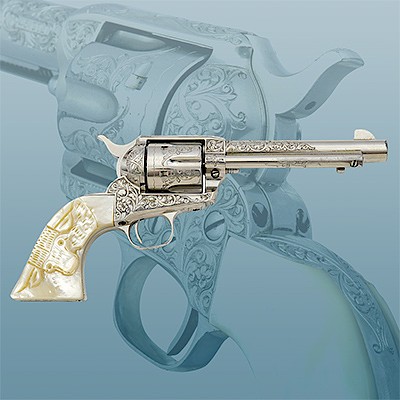Exceptional Silver-Mounted NRA Presentation Flintlock Long Rifle by Cecil Brooks
About Seller
250 Commercial Street
Manchester, NH 03101
United States
Amoskeag Auction Company is a specialty firearms auction company based in New Hampshire. Our experience and location have allowed us to create a highly advantageous environment for marketing collectible firearms at auction. This environment coupled with our high level of integrity and rigorous work ...Read more
Two ways to bid:
- Leave a max absentee bid and the platform will bid on your behalf up to your maximum bid during the live auction.
- Bid live during the auction and your bids will be submitted real-time to the auctioneer.
Bid Increments
| Price | Bid Increment |
|---|---|
| $0 | $10 |
| $100 | $25 |
| $500 | $50 |
| $1,000 | $100 |
| $3,000 | $250 |
| $5,000 | $500 |
| $10,000 | $1,000 |
| $20,000 | $2,500 |
| $50,000 | $5,000 |
| $100,000 | $10,000 |
About Auction
Nov 17, 2018
Fine Antique and Collectable Sporting and Military Arms Featuring items from the collections of Cletus Klein, Tim Falvey, Dr. Jess Lewis, Dr. Louis C. March Jr., Roy Jinks & Others Amoskeag Auction Company amanda@amoskeagauction.com
- Lot Description
serial #50, .38 cal., 45 1/2'' octagon barrel with a bright excellent, likely unfired, bore. This is a stunning rifle and was presented to Gen. Leonard F Chapman Jr, Commandant of the United States Marine Corps 1968-1972. The barrel has a nice German silver front sight with hand matting on three facets surrounding it with similar matting around the flat-top rear sight and engraved loose flowing scroll surrounding the makers mark ''CG Brooks'' inlaid in a silver field on the barrel. The nice geometric engraving continues onto the long tang and the barrel itself is a dull pewter patina with a widely scattered, very sparse remnant of an oxidation stain here and there. The bridled roller frizzen lock is profusely engraved and maker marked ''Brooks'' featuring a nicely chiseled frizzen spring. The gun features overall lovely silver mounts in the form of a nosecap, four barrel wedge escutcheons, three lovely faceted and engraved ramrod thimbles with a faceted engraved tailpipe, engraved forestock plate, faceted triggerguard with engraved front and rear extensions and silver butt and toeplates, neatly engraved with scroll and floral motifs. One of the more stunning features of the rifle is its ornate pierced patchbox which is also profusely engraved and has dual sterling silver floral overlays. The patchbox features a bottom release and is neatly engraved with the presentation ''Traditional Flintlock Rifle/Presented To/Gen. Leonard F Chapman Jr. USMC/Commandant US Marine Corps/by the National Rifle Association of America/at its 98th Annual Members Banquet/1 April 1969''. The trigger is a fancy pierced scroll design and the sideplate is lovely, flowing and pierced. There are six geometric silver inlays, all neatly engraved and there is a vent pick inlay beneath the cheekpiece, also neatly engraved (the vent pick is currently missing). The stock rates excellent to very nearly as new with a nice low-gloss varnish finish showing a light handling mark here or there from being appreciated over the years. Mr. Brooks has incorporated lovely carved-in-relief flowing scroll ahead of the pinched comb, surrounding the tang, and behind the cheekpiece ahead of the buttplate while the stock flats have teardrop points and neat carved accents. The original mahogany or rosewood ramrod is included and the rifle functions well mechanically. Included with the gun is its original powderhorn. The horn is 15'' with a semi-bulbous maple plug banded by silver and shows a reduction at the nozzle with a silver spout (the cap is missing). The horn is engraved ''Chappy Chapman/His Horn/1969'' along with the general's dates of promotion from Second Lieut. right up to Commandant of the Marine Corps. There are four silver applied stars, an applied silver monogram plate which is un-engraved and there are additional silver stars applied with loops as hanger provision. Mr. Brooks's rifles are the thing of legend, he having constructed every NRA presentation long rifle since 1955 until his passing in 2006 at the age of 93. General Leonard F Chapman Jr. U.S.M.C. was nothing short of a legend himself. During the Second World War he was involved with the Battle of Coral Sea, the Battle of Midway, and later on Peleliu and Okinawa earning the Navy Commendation Ribbon with Combat ''V''; the Legion of Merit with Combat ''V''; and the Bronze Star Medal with Combat ''V''. Postwar he would serve diligently in the Corps being promoted to Brig. Gen. in July 1958 and Maj. Gen. in November 1961. In 1963 he was awarded his second Legion of Merit, in 1964 becoming a Chief of Staff and was awarded the Distinguished Service Medal by the Secretary of the Navy. In July 1967 he became the Assistant Commandant of the Marine Corps and in December of that year was nominated by President Lyndon Johnson to become the Commandant, being confirmed by the U.S. Senate December 13 of that year. He traveled heavily visiting Marines around the globe and went to Vietnam twice, once in 1968 and once in 1969 (both his Marine sons were there as well). Gen. Chapman directed the withdrawal of US Marine forces from Vietnam and was determined to bring back his two Marine divisions with all their equipment, telling his troops, ''Don't leave anything behind worth more than five dollars.'' Post-war, the Marines faced problems of racial hostility and violence and after a near riot at Camp LeJeune in 1969, General Chapman was adamant in taking positive steps to eliminate discrimination in promotions, assignments and in social activity on the bases. ''Every marine must understand that the Marine Corps. does guarantee equal rights, equal opportunity, and equal protections, without regard to race,'' he wrote. When other branches of the service made moves to relax standards and discipline and to allow long hair and facial hair and to ease inspections and early reveille the Commandant was having none of it. ''Marines don't do that'' was his answer. Instead his policy was to ''tighten up and toughen up'' and he maintained the Marine Corps as a smaller but absolutely combat-ready and highly-efficient organization. When he retired as a four-star general in 1971, he was awarded the Distinguished Service Medal by President Richard M. Nixon; receiving a gold star in lieu of a third award, the presentation calling Chapman ''A splendid leader with enduring values and great patriotism, General Chapman, during four years as its Commandant, led the Marine Corps through the height of the Vietnam Conflict and the process of returning to peacetime posture. With keen foresight and conviction, General Chapman forged a renewed Corps emphasizing readiness, equality, and professionalism. By his dedicated and distinguished service during more than thirty-six years of devoted duty, General Chapman has contributed greatly to the success of the United States and friendly forces engaged in the protection of citizens of free nations, thereby upholding and contributing to the highest traditions of the Marine Corps and the United States Naval Service.''. Nixon appointed him as Commissioner of Immigration and Naturalization from 1973 until 1976, promoting a curb on illegal immigration that he said was costing the country billions of dollars a year. Gen. Chapman passed away in 2000 and was buried with full military honors at Arlington with over 700 mourners in attendance. He was remembered as the consummate Marine, a gentleman in all respects and the epitome of what a Marine should be. Gen. Mundy said of him ''..on the day he retired he was still the sharpest Marine I have ever known.''; truly a Marines Marine. Very rarely do these Brooks presentation rifles come up for public sale; this example presented to a distinguished Marine and a true American Hero. originally consigned to Amoskeag directly by the family and purchased by Cletus Klein who was only the second owner of the rifle. (38937-415) {ANTIQUE} [Cletus Klein Collection]
- Shipping Info
-
Amoskeag Auction Company, Inc. will make every effort to ship items in a timely fashion. All items, with the exception of modern handguns, are shipped via UPS Ground unless other arrangements have been made. • All modern handguns are shipped via UPS Next Day Air service. • Buyer is responsible for any and all shipping charges. • Orders are shipped in the order in which they are paid. PICKING UP MERCHANDISE • OUR OFFICE WILL BE CLOSED MONDAY AND TUESDAY FOLLOWING THE SALE. No merchandise will be delivered on those days. We will resume normal business hours on Wednesday. • Our office hours are Monday through Friday - 8:00 am to 4:00pm. Please call ahead prior to arriving to pickup your merchandise.
-
- Buyer's Premium



 EUR
EUR CAD
CAD AUD
AUD GBP
GBP MXN
MXN HKD
HKD CNY
CNY MYR
MYR SEK
SEK SGD
SGD CHF
CHF THB
THB


















